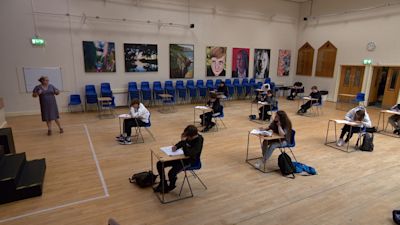What happens if someone tests positive for coronavirus at school

Schools across the UK have finally reopened, but with coronavirus cases across the country rising there are fears the increased contact will lead to further outbreaks.
In order to try and reduce the chance of infection between pupils, the government has produced a huge list of guidelines that have shaken the usual school day entirely.
It's all in the name of ensuring everyone is kept safe, but what will happen if someone at a school does test positive for Covid-19?
What happens if someone at the school tests positive for Covid-19?
Each case will be different and the response will be proportionate to how many people test positive, and if they are pupils or teachers.
One of the main rules in the guidelines about reopening schools includes the provision that pupils be broken up into "bubbles."
New restrictions for Bolton as young people urged to help reduce Covid-19 spread
Health secretary Matt Hancock 'concerned' by surge in coronavirus cases
No silver bullet to deal with quarantine and Covid-19 at airports, insists Raab
As within wider society, each bubble will be kept separate from the other ones, meaning playgrounds may be broken up into different areas for each group, and start times may be staggered to avoid crowding at entrances.
Schools have each determined what a bubble is depending on the size of their building and the number of pupils they have, but generally they are either entire year groups or half of one.
This means there can be hundreds of children in each bubble and if one of them tests positive for the virus the entire bubble could be told to self-isolate.
A school is considered to have an outbreak of Covid-19 if there are two or more confirmed cases within 14 days.
When this happens the school will initiate a tack and trace operation, and receive support from local health authorities.
What if a member of staff tests positive?
If a member of staff tests positive at a school then it is slightly different and the response will likely be based more on a case by case basis.
Teachers and all staff should be maintaining social distancing from pupils at all times.
In some secondary schools, teachers may have to move between different bubbles regularly to teach their different classes and if they test positive many more bubbles could be affected.
Supply teachers are also allowed to move between schools, creating an even larger group of people at risk, but this is why social distancing is important to minimise any potential contact.
If a large number of pupils test positive for the virus across different bubbles then the whole school may be closed - but the government has insisted that won't usually be necessary.
What have schools who have already suffered outbreaks done so far?
There is already a pattern emerging as several schools across the UK have confirmed Covid-19 cases among either their pupils or staff.
A school in Suffolk was forced to close today after five members of staff tested positive for coronavirus.
Samuel Ward Academy has said they will reopen after the school has had a deep clean and they have investigated how the virus was spread.
Another school in Cardiff was forced to send 30 pupils home after one of them tested positive for the virus.
The school has remained open and is carrying out a deep clean of the area used by the pupils but no one else will need to self-isolate.
Three schools in Teeside also had to take action after several coronavirus cases were confirmed, but all have stayed open.
Year 11 students and staff at Liverpool College were told to self-isolate after one of them tested positive for the virus, but it has remained open.
What if a pupil or staff member develops coronavirus symptoms?
If anyone develops coronavirus symptoms they should not attend school and should inform the staff.
The school should then order a test if the parents or family haven't already.
If the person tests negative and their symptoms go away they can return to school.
If they test positive they should inform the school as soon as possible and enter self-isolation along with the rest of their household.
Self-isolation rules are the same for all cases, a person who tests positive should isolate for 10 days.
Anyone who has been in contact with them must self-isolate for 14 days.
What preventative measures are schools taking?
Along with the already mentioned bubbles, schools are taking extra precautions to ensure the chance of spreading the virus is limited.
Face coverings in corridors and communal areas are mandatory in England in areas in local lockdown.
Other schools have the option of enforcing mask-wearing in certain areas, even if they are not in an area seeing enhance lockdown measures.
Social distancing is also enforced in classrooms and wherever possible.
If coronavirus numbers in an area get really high, then a school may be forced to enter into a two-week rota system, where pupils spend two weeks learning from home, and two weeks in class.
Enhanced cleaning measures and hand sanitiser stations are also in place.
Health secretary Matt Hancock 'concerned' by surge in coronavirus cases
Coronavirus: Students return to classrooms as unions call for pause on school absence fines